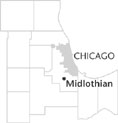| Entries |
| M |
|
Midlothian, IL
|
 Cook County, 18 miles S of the Loop. Midlothian is bordered by
Crestwood
and
Robbins
to the north,
Posen
to the east,
Markham
to the south, and
Oak Forest
to the west, and shares a history with all of these communities.
Cook County, 18 miles S of the Loop. Midlothian is bordered by
Crestwood
and
Robbins
to the north,
Posen
to the east,
Markham
to the south, and
Oak Forest
to the west, and shares a history with all of these communities.
Most of the surface of Midlothian is on the lake plain formed by glacial Lake Chicago as a result of the Wisconsin glacier (12,000 BP). In the southwestern corner, the Tinley Moraine passes through from northwest to southeast.
Evidence of Native American occupation in the area of Midlothian abounds, especially just south of town at the Oak Forest site. The site, on the Tinley Moraine overlooking a marshy area of glacial lake plain, dates to the 1600s. The Potawatomi were the last Native American occupants of the area. The Old Indian Boundary Line crosses to the southeast of the village. The Midlothian area and additional land to the northwest of this line were ceded in 1816 in the Treaty of St. Louis.
The early record of European occupation of the Midlothian area is the history of Bremen Township, which was first settled by Yankee farmers in the early 1830s, followed by German and Irish immigrants in the 1840s and 1850s. Midlothian was first called Rexford Crossing and was a milk stop where the Rock Island line crossed Crawford Avenue.

|
A small community developed around the station, with residential development beginning in 1915, an elementary school in 1919, and incorporation in 1927.
With the growth of population came the founding of the community's major religious congregations: St. Christopher Roman Catholic in 1922, Midlothian United Methodist in 1925, Hope Lutheran and Concordia Lutheran in 1925. The Lutherans merged in 1973 as St. Stephen Lutheran Church. St. Christopher was the patron saint of travelers, and a tradition of blessing motorcycles developed at the Catholic church.
The Great Depression hurt many families in Midlothian, but attracted those who were employed and wanted better housing, such as Harry Raday, who served as mayor from 1961 to 1985. Midlothian has developed as a residential community, noted for its low taxes.
Midlothian was the home of the Highland Games from 1973 to 1981, a reminder of its Scottish name. Although the games became a major regional attraction, financial and legal problems caused their demise.
| Midlothian, IL (inc. 1927) | |||||
| Year |
Total
(and by category) |
Foreign Born | Native with foreign parentage | Males per 100 females | |
| 1930 | 1,775 | 12.5% | 30.0% | 109 | |
| 1,775 | White (100.0%) | ||||
| 1960 | 6,605 | 4.7% | 21.6% | 100 | |
| 6,600 | White (99.9%) | ||||
| 5 | Other races (0.1%) | ||||
| 1990 | 14,372 | 2.2% | — | 96 | |
| 13,691 | White (95.3%) | ||||
| 352 | Black (2.4%) | ||||
| 38 | American Indian (0.3%) | ||||
| 126 | Asian/Pacific Islander (0.9%) | ||||
| 165 | Other race (1.1%) | ||||
| 490 | Hispanic Origin* (3.4%) | ||||
| 2000 | 14,315 | 3.8% | — | 95 | |
| 12,636 | White alone (88.3%) | ||||
| 877 | Black or African American alone (6.1%) | ||||
| 22 | American Indian and Alaska Native alone (0.2%) | ||||
| 236 | Asian alone (1.6%) | ||||
| 3 | Native Hawaiian and Other Pacific Islander alone (0.0%) | ||||
| 322 | Some other race alone (2.2%) | ||||
| 219 | Two or more races (1.5%) | ||||
| 976 | Hispanic or Latino* (6.8%) | ||||
The Encyclopedia of Chicago © 2004 The Newberry Library. All Rights Reserved. Portions are copyrighted by other institutions and individuals. Additional information on copyright and permissions.